Correlation Analysis of Ultrasonic Pulse Velocity and Mechanical Properties of Normal Aggregate and Lightweight Aggregate Concretes in 30–60 MPa Range
Abstract
1. Introduction
2. Experimental Procedure
2.1. Materials
2.2. Experimental Program and Concrete Mix Proportion
2.3. Test Methods
3. Results and Discussion
3.1. Mechanical Properties of NC and LC
3.2. Relative Mechanical Properties between NC and LC
3.3. Comparison between Compressive Strength and Ultrasonic Pulse Velocity
3.4. Comparison between Elastic Modulus and Ultrasonic Pulse Velocity
3.5. Proposed Prediction Equations of Compressive Strength and Elastic Modulus by Ultrasonic Pulse Velocity
4. Conclusions
Author Contributions
Funding
Institutional Review Board Statement
Informed Consent Statement
Data Availability Statement
Conflicts of Interest
References
- Choi, S.J.; Kim, D.B.; Lee, K.S.; Kim, Y.U. The study on the physical and strength properties of Lightweight aggregate concrete by replacement ratio of artificial lightweight aggregate. J. Korea Inst. Build. Constr. 2019, 19, 313–322. [Google Scholar]
- Kohno, K.; Okamoto, T.; Isikawa, Y.; Sibata, T.; Mori, H. Effect of artificial Lightweight aggregate on autogenous shrinkage of concrete. Cem. Concr. Res. 1999, 29, 611–614. [Google Scholar] [CrossRef]
- Sim, J.I.; Yang, K.-H. Influence of specimen geometries on the compressive strength of lightweight aggregate concrete. J. Korea Concr. Inst. 2012, 24, 333–340. [Google Scholar] [CrossRef][Green Version]
- Kim, Y.J.; Choi, Y.W. The quality properties of self consolidating concrete using lightweight aggregate. J. Civ. Environ. Eng. 2010, 30, 573–580. [Google Scholar]
- Kim, S.C.; Park, K.C.; Choi, H.W. An experimental study for the strength variations of high-strength Lightweight aggregate concrete according to grain-size of artificial Lightweight aggregate. Korea Inst. Struct. Maint. Insp. 2011, 15, 206–217. [Google Scholar]
- Andiç-Çakır, Ö.; Hizal, S. Influence of elevated temperatures on the mechanical properties and microstructure of self consolidating Lightweight aggregate concrete. J. Constr. Build. Mater. 2012, 34, 575–583. [Google Scholar] [CrossRef]
- Chandra, S.L. Berntsson, Lightweight Aggregate Concrete; Noyes Publications: New York, NY, USA, 2002. [Google Scholar]
- Ding, F.; Wu, X.; Xiang, P.; Yu, Z. New damage ratio strength criterion for concrete and lightweight aggregate concrete. ACI Struct. J. 2021, 118, 165–178. [Google Scholar]
- Roufael, G.; Beaucour, A.L.; Eslami, J.; Hoxha, D.; Noumowé, A. Influence of Lightweight aggregates on the physical and mechanical residual properties of concrete subjected to high temperatures. J. Constr. Build. Mater. 2021, 268, 121221. [Google Scholar] [CrossRef]
- Park, C.B.; Kim, Y.H.; Jun, Y.B.; Kim, J.H.; Ryu, D.H. Durabilities of Lightweight aggregate concrete and natural aggregate concrete. J. Korea Inst. 2021, 33, 227–234. [Google Scholar] [CrossRef]
- Kim, H.M.; Ling, T.C.; Alengaram, U.J.; Yap, S.P.; Yeun, C.W. Overview of supplementary cementitious materials usage in Lightweight aggregate concrete. J. Constr. Build. Mater. 2017, 139, 403–418. [Google Scholar]
- ACI Committee 301; Specifications for structural concrete (ACI 301M-16). American Concrete Institute: Farmington Hills, MI, USA, 2016; p. 64.
- ACI Committee 211.2; Standard practice for selecting proportions for structural Lightweight aggregate concrete (ACI 211.2-98). American Concrete Institute: Farmington Hills, MI, USA, 1998; p. 18.
- ACI Committee 213; Guide for structural lightweight-aggregate concrete (ACI 213R-14). American Concrete Institute: Farmington Hills, MI, USA, 2014; p. 53.
- ASTM C330/C330M; Standard Specification for Lightweight Aggregates for Structural Concrete. American Society of Testing and materials (ASTM): West Conshohocken, PA, USA, 2017; pp. 1–4.
- Architectural Institute of Japan. Japanese Architectural Standard Specification for Reinforced Concrete Work (JASS 5); English Version; Architectural Institute of Japan: Tokyo, Japan, 2009; pp. 74–77. [Google Scholar]
- Shafigh, P.; Nomeli, M.A.; Alengaram, U.J.; Mahmud, H.B.; Jumaat, M.Z. Engineering properties of lightweight aggregate concrete containing limestone powder and high volume fly ash. J. Clean. Prod. 2016, 135, 148–157. [Google Scholar] [CrossRef]
- Nikbin, I.M.; Aliaghazadeh, M.; Charkhtab, S.; Fathollahpour, A. Environmental impacts and mechanical properties of Lightweight aggregate concrete containing bauxite residue (red mud). J. Clean. Prod. 2018, 172, 2683–2694. [Google Scholar] [CrossRef]
- Majhi, R.K.; Padhy, A.; Nayak, A.N. Performance of structural lightweight aggregate concrete produced by utilizing high volume of fly ash cenosphere and sintered fly ash aggregate with silica fume. Clean. Eng. Technol. 2021, 3, 100121. [Google Scholar] [CrossRef]
- Akçaözog˘lu, S.; Akçaözog˘lu, K.; Atis, C.D. Thermal conductivity, compressive strength and ultrasonic wave velocity of cementitious composite containing waste PET Lightweight aggregate (WPLA). J. Compos. Part B Eng. 2013, 45, 721–726. [Google Scholar] [CrossRef]
- Lee, T.G.; Lee, J.H. Assessment of strength development at hardened stage on high-strength concrete using NDT. Appl. Sci. 2020, 10, 6261. [Google Scholar] [CrossRef]
- Pyszipiak, J. Method of concrete strength control in prefabricated slabs by ultrasound. Build. Sci. 1948, 2, 331–335. [Google Scholar] [CrossRef]
- JASS 5; Japanese Architectural Standard Specification. Architectural Institute of Japan: Tokyo, Japan, 2009.
- Kim, M.H.; Choi, S.J.; Kim, Y.R.; Jang, J.H.; Kim, J.H.; Yoon, J.K. A Study on the proposal of strength presumption equation and evaluation of practical application of high strength concrete by non-destructive test. J. Archit. Inst. Korea 2004, 20, 55–62. [Google Scholar]
- ASTM C1231/C1231-15; Standard Practice for Use of Unbonded Caps in Determination of Compressive Strength of Hardened Cylindrical Concrete Specimens. American Society of Testing and Materials (ASTM): West Conshohocken, PA, USA, 2016; pp. 1–5.
- ASTM C39/C39M; Standard Test Method for Compressive Strength of Cylindrical Concrete Specimens. American Society of Testing and Materials (ASTM): West Conshohocken, PA, USA, 2018; pp. 1–8.
- ASTM C597-16; Standard Test Method for Pulse Velocity Through Concrete. American Society of Testing and Materials (ASTM): West Conshohocken, PA, USA, 2016; pp. 1–4.
- ASTM C469; Standard Test Method for Static Modulus of Elasticity and Poisson’s Ratio of Concrete in Compression, 469. Annual Book of ASTM Standards: Philadelphia, PA, USA, 2011.
- Lee, T.G.; Lee, J.H. Proposal of prediction model of settling time and compressive strength of concrete by nondestructive ultrasonic pulse velocity at early age. J. Constr. Build. Mater. 2020, 252, 119027. [Google Scholar] [CrossRef]
- Ben-Zeitun, E.A. Use of pulse velocity to predict compressive strength of concrete. J. Cem. Compos. Lightweight Aggreg. Concr. 1986, 8, 51–59. [Google Scholar] [CrossRef]
- Farahani, J.N.; Shafigh, P.; Alsubari, B.; Shahnazar, S.; Mahmud, H.B. Engineering properties of lightweight aggregate concrete containing binary and ternary blended cement. J. Clean. Prod. 2017, 149, 976–988. [Google Scholar] [CrossRef]
- Ga, R.D.; Türkmen, I.; Karakoc, M.B. Relationship between ultrasonic velocity and compressive strength for high–volume mineral–admixtured concrete. Cem. Concr. Res. 2004, 34, 2329–2336. [Google Scholar]
- Trtnik, G.; Kavčič, F.; Turk, G. Prediction of concrete strength using ultrasonic pulse velocity and artificial neural networks. J. Ultrason. 2009, 49, 53–60. [Google Scholar] [CrossRef] [PubMed]
- Shariq, M.; Prasad, J.; Masood, A. Studies in ultrasonic pulse velocity of concrete containing GGBFS. J. Constr. Build. Mater. 2013, 40, 944–950. [Google Scholar] [CrossRef]
- Mohammed, B.S.; Azmi, N.J.; Abdullahi, M. Evaluation of rubbercrete based on ultrasonic pulse velocity and rebound hammertests. J. Constr. Build. Mater. 2011, 25, 1388–1397. [Google Scholar] [CrossRef]
- Karimaei, M.; Dabbaghi, F.; Dehestani, M.; Rashidi, M. Estimating compressive strength of concrete containing untreated coal waste aggregates using ultrasonic pulse velocity. Materials 2021, 14, 647. [Google Scholar] [CrossRef] [PubMed]
- Mohanmmed, T.U.; Rahman, M.N. Effect of types of aggregate and sand-to-aggregate volume ratio on UPV in concrete. J. Constr. Build. Mater. 2016, 125, 832–841. [Google Scholar] [CrossRef]
- Zhang, Y.; Aslani, F. Compressive strength prediction models of Lightweight aggregate concretes using ultrasonic pulse velocity. J. Constr. Build. Mater. 2021, 292, 123419. [Google Scholar] [CrossRef]
- Naniz, O.A.; Mazloom, M. Effects of colloidal nano-silica on fresh and hardened properties of self-compacting Lightweight aggregate concrete. J. Build. Eng. 2018, 20, 400–410. [Google Scholar] [CrossRef]
- Kim, M.W.; Oh, H.S.; Oh, K.C. Estimating the compressive strength of high-strength concrete using surface rebound value and ultrasonic velocity. J. Korea Inst. Struct. Maint. Insp. 2016, 20, 1–9. [Google Scholar]
- TLee, G.; Kang, Y.W.; Choi, H.G.; Choe, G.C.; Kim, G.Y. Suggestion for non-destructive testing equation to estimate compressive strength of early strength concrete. J. Korea Inst. Build. Constr. 2016, 16, 229–235. [Google Scholar]
- Kaplan, G.; Yaprak, H.; Memiş, S.; Alnkaa, A. Artificial neural network estimation of the effect of varying curing conditions and cement type on hardened concrete properties. Buildings 2019, 9, 10. [Google Scholar] [CrossRef]
- Shetty, M. Concrete Technology; Chand & Company LTD: Ram Nagar, New Delhi, India, 2005; pp. 420–453. [Google Scholar]
- Qurashi, M.A.; Shah, S.A.R.; Farhan, M.; Taufiq, M.; Khalid, W.; Arshad, H.; Tayyab, M.; Shahzadi, G.; Waseem, M. Sustainable design and engineering: A relationship analysis between digital destructive and non-destructive testing process for lightweight concrete. Processes 2019, 7, 791. [Google Scholar] [CrossRef]
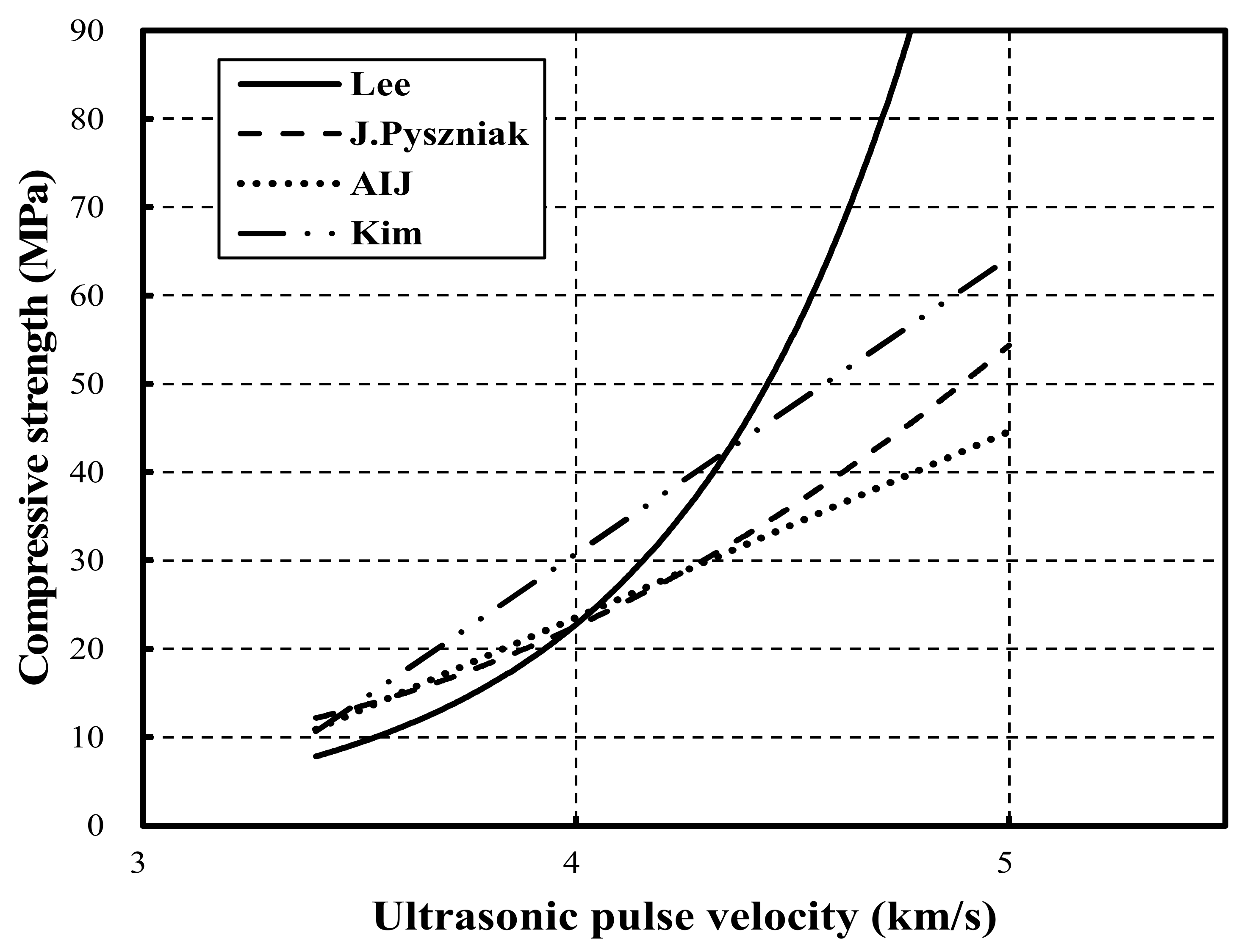

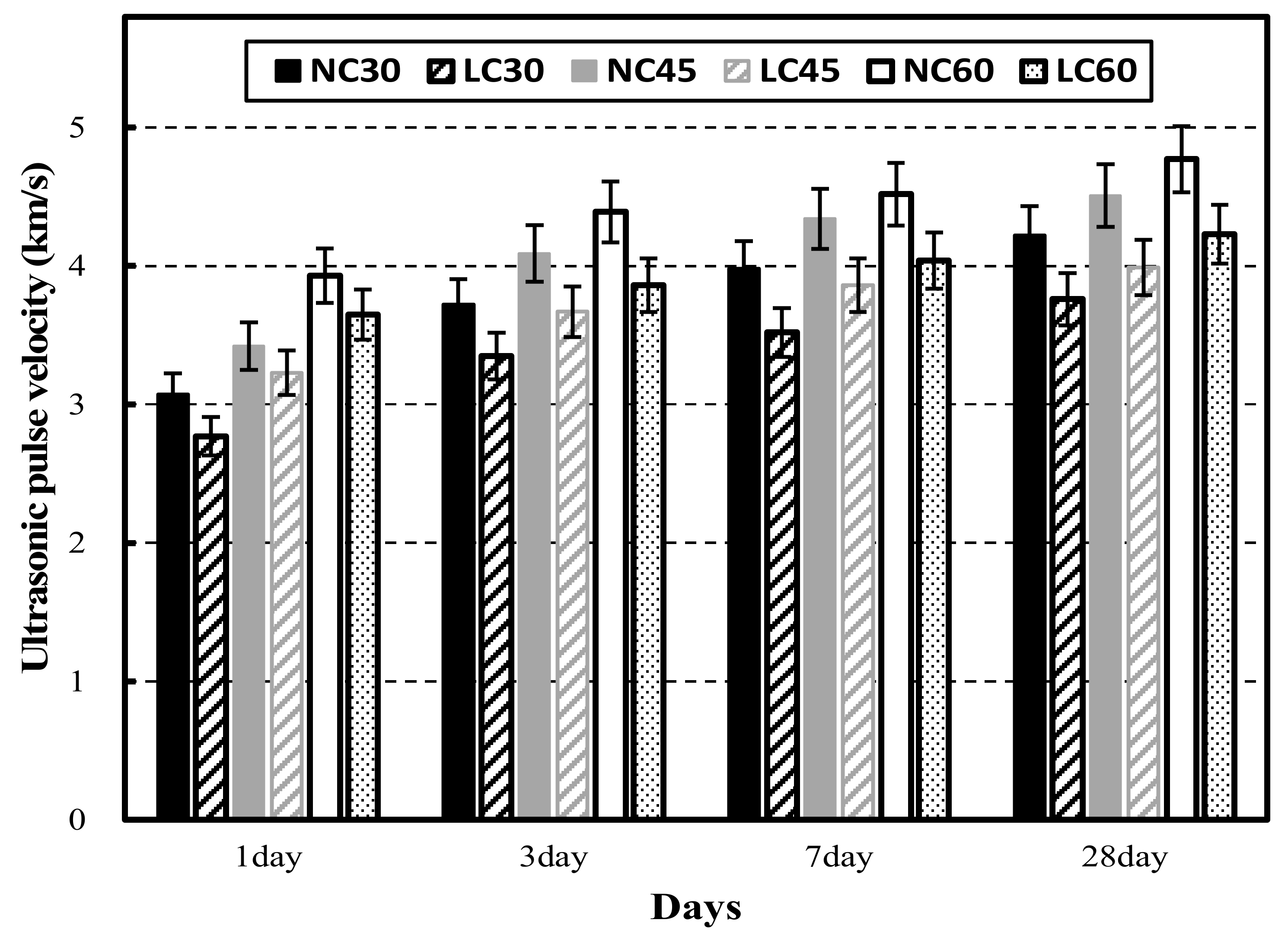



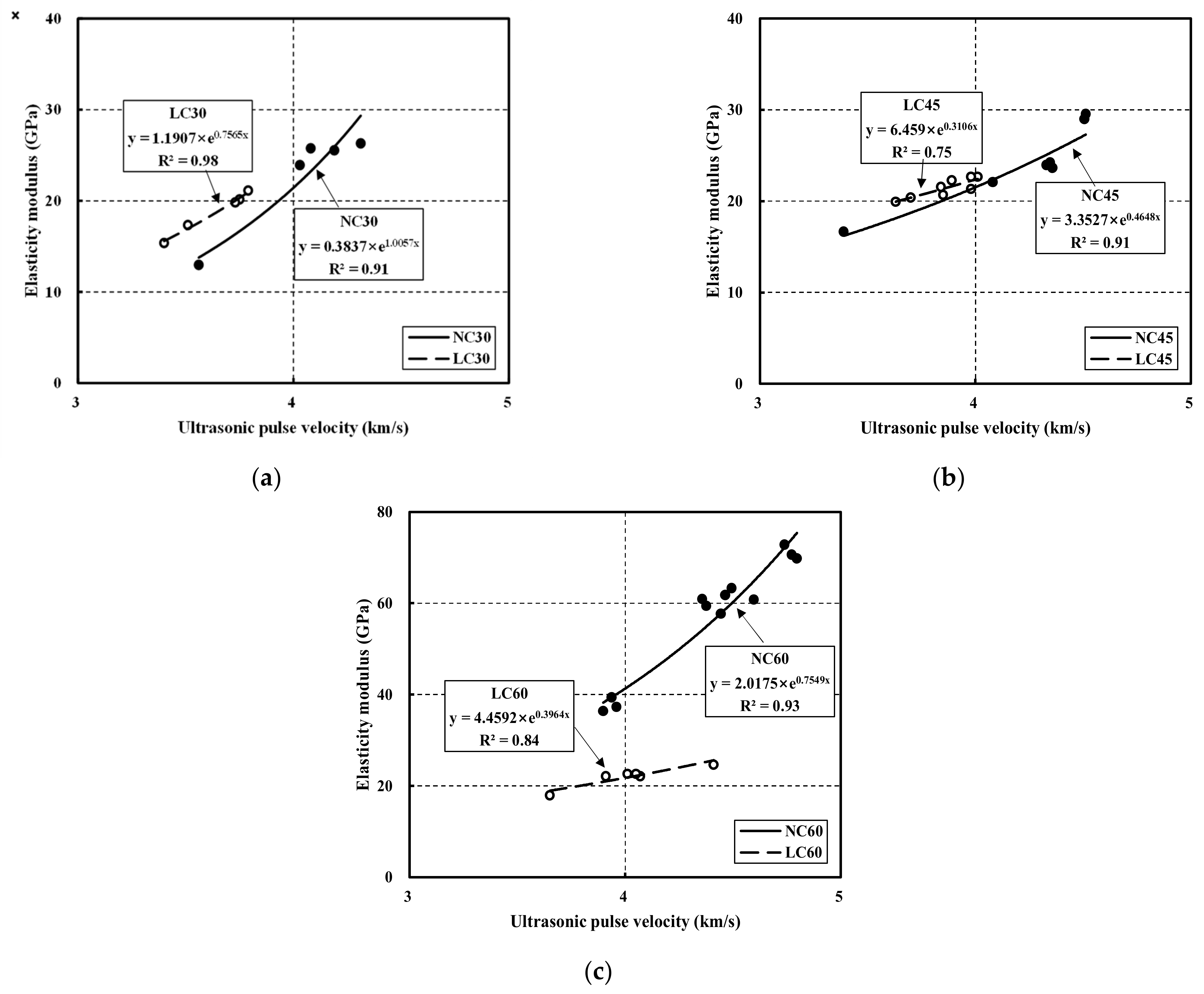
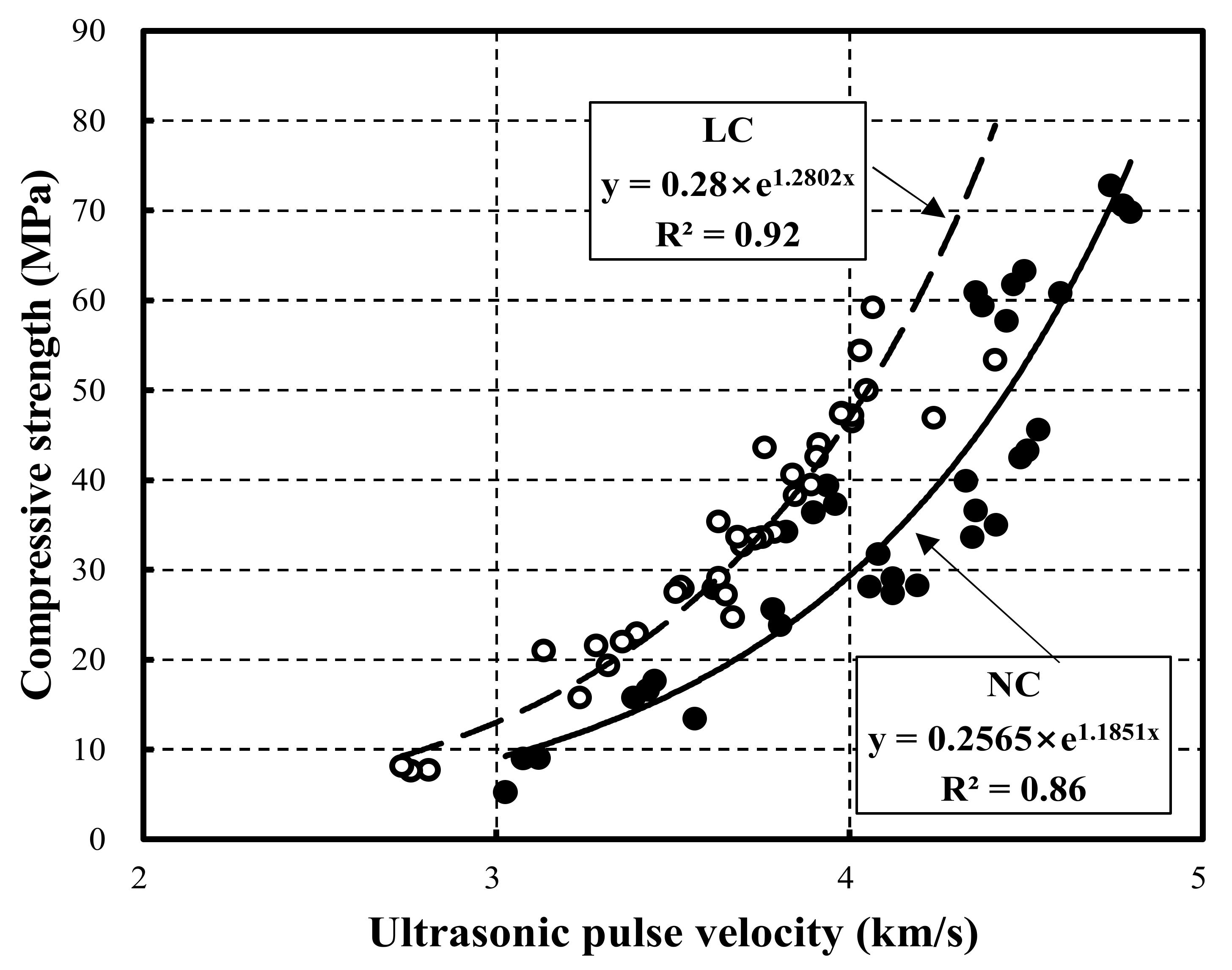
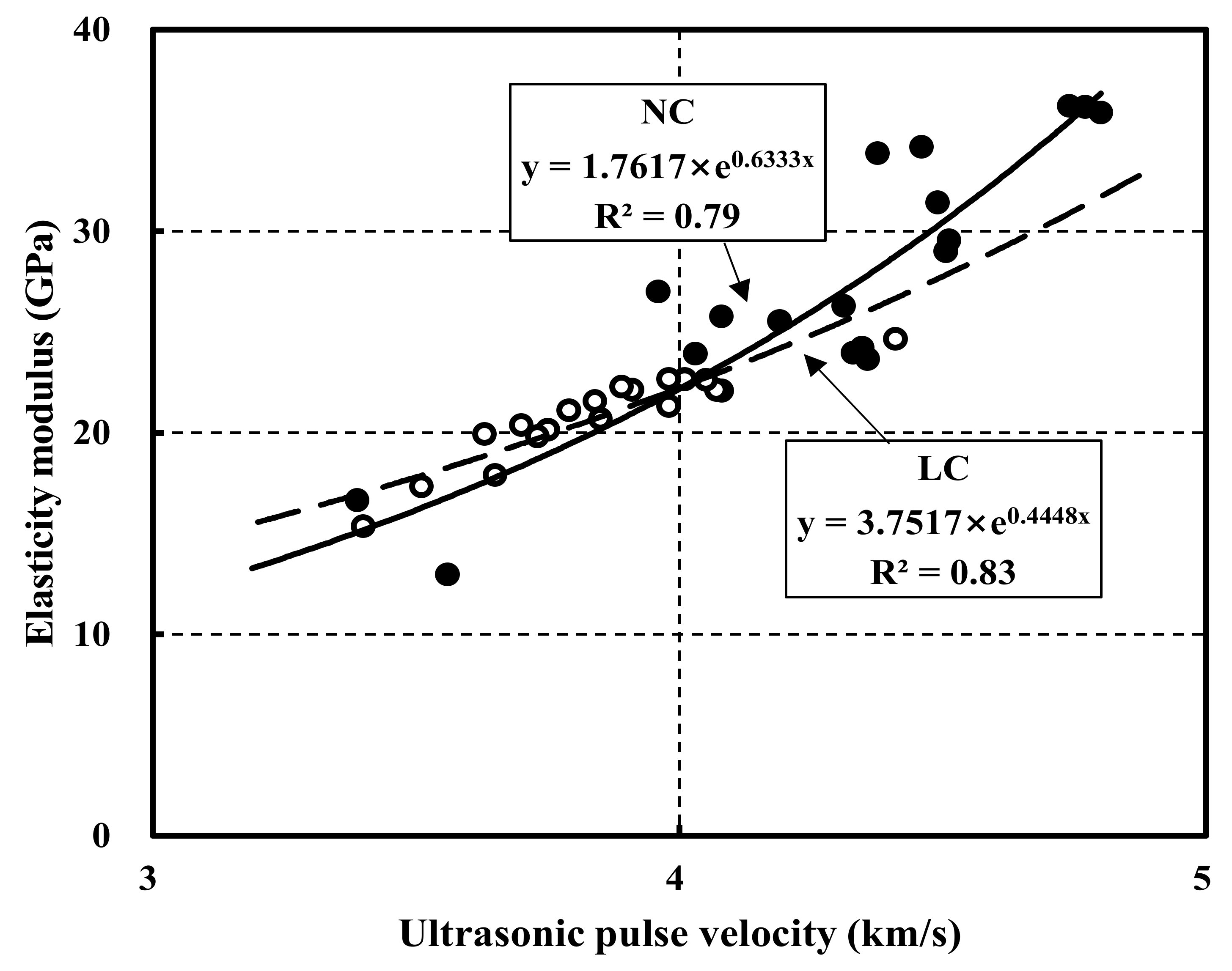

| Researcher | Prediction Equation |
|---|---|
| Lee [21] | Fc = 0.0184 × e1.78 Vp |
| J. Pyszniak [22] | Fc = (92.5 Vp2 − 508 Vp + 782)/10.2 |
| AIJ [23] | Fc = (215 Vp − 620)/10.2 |
| Kim [24] | Fc = 33.53 Vp − 103.38 |
| Materials | Properties |
|---|---|
| Cement | Type I ordinary Portland cement Density: 3150 kg/m3, fineness: 320 m2/kg |
| Coarse aggregate | Crushed granite aggregate Density: 2680 kg/m3, fineness modulus: 7.03 Absorption: 0.68%, maximum size: 20 mm |
| Coal ash aggregate Density: 1470 kg/m3, fineness modulus: 6.39 Absorption: 8.68%, maximum size: 20 mm | |
| Fine aggregate | River sand Density: 2540 kg/m3, fineness modulus: 2.54 absorption: 1.6% |
| Super plasticizer | Polycarboxylic-based acid |
| Materials | Chemical Composition (%) | L.O.I | |||||||
|---|---|---|---|---|---|---|---|---|---|
| CaO | SiO2 | Al2O3 | Fe2O3 | MgO | SO3 | K2O | Others | ||
| OPC | 60.3 | 19.8 | 4.9 | 3.3 | 3.8 | 2.9 | 1.1 | 0.9 | 3 |
| Classification | Tests Conditions |
|---|---|
| Specimen dimension | Φ100 × 200 mm |
| Type of coarse aggregate | Crushed granite aggregate, Coal ash aggregate |
| Purpose compressive strength | 30, 45, and 60 MPa |
| Curing conditions | Room temperature: 20 ± 2 °C, Humidity: 60 ± 5% |
| Test items | Compressive strength (MPa), ultrasonic pulse velocity (km/s), Elastic modulus (GPa) |
| MIX ID | fck (MPa) | W/B | S/a (%) | Unit Weight (kg/m3) | |||
|---|---|---|---|---|---|---|---|
| W | C | S | G | ||||
| LC30 | 30 | 0.41 | 46.0 | 165 | 400 | 799 | 758 |
| NC30 | 400 | 799 | 956 | ||||
| LC45 | 45 | 0.33 | 43.0 | 500 | 711 | 762 | |
| NC45 | 500 | 711 | 961 | ||||
| LC60 | 60 | 0.28 | 43.0 | 600 | 676 | 724 | |
| NC60 | 600 | 676 | 913 | ||||
| Test Items | Test Method | Test Ages |
|---|---|---|
| Compressive strength (MPa) | ASTM C39/C39M [26] | 1, 3, 7, 28 day |
| Ultrasonic pulse velocity (km/s) | ASTM C597 [27] | |
| Elastic modulus (GPa) | ASTM C469 [28] | 3, 7, 28 day |
| ID | Equation | Correlation Coefficient (R2) |
|---|---|---|
| NC30 | Fc = 0.1945 × e1.2372Vp | R2 = 0.79 |
| LC30 | Fc = 0.1251 × e1.5176Vp | R2 = 0.97 |
| NC45 | Fc = 0.8276 × e0.8764Vp | R2 = 0.98 |
| LC45 | Fc = 0.432 × e1.1755Vp | R2 = 0.92 |
| NC60 | Fc = 2.0175 × e0.7549Vp | R2 = 0.93 |
| LC60 | Fc = 0.9628 × e0.9576Vp | R2 = 0.65 |
| ID | Equation | Correlation Coefficient(R2) |
|---|---|---|
| NC30 | E = 0.3837 × e0.0057Vp | R2 = 0.91 |
| LC30 | E = 1.1907 × e0.7565Vp | R2 = 0.98 |
| NC45 | E = 3.3527 × e0.4648Vp | R2 = 0.91 |
| LC45 | E = 6.459 × e0.3106Vp | R2 = 0.75 |
| NC60 | E = 2.0175 × e0.7549Vp | R2 = 0.93 |
| LC60 | E = 4.4592 × e0.3964Vp | R2 = 0.84 |
Publisher’s Note: MDPI stays neutral with regard to jurisdictional claims in published maps and institutional affiliations. |
© 2022 by the authors. Licensee MDPI, Basel, Switzerland. This article is an open access article distributed under the terms and conditions of the Creative Commons Attribution (CC BY) license (https://creativecommons.org/licenses/by/4.0/).
Share and Cite
Kim, W.; Jeong, K.; Choi, H.; Lee, T. Correlation Analysis of Ultrasonic Pulse Velocity and Mechanical Properties of Normal Aggregate and Lightweight Aggregate Concretes in 30–60 MPa Range. Materials 2022, 15, 2952. https://doi.org/10.3390/ma15082952
Kim W, Jeong K, Choi H, Lee T. Correlation Analysis of Ultrasonic Pulse Velocity and Mechanical Properties of Normal Aggregate and Lightweight Aggregate Concretes in 30–60 MPa Range. Materials. 2022; 15(8):2952. https://doi.org/10.3390/ma15082952
Chicago/Turabian StyleKim, Wonchang, Keesin Jeong, Hyeonggil Choi, and Taegyu Lee. 2022. "Correlation Analysis of Ultrasonic Pulse Velocity and Mechanical Properties of Normal Aggregate and Lightweight Aggregate Concretes in 30–60 MPa Range" Materials 15, no. 8: 2952. https://doi.org/10.3390/ma15082952
APA StyleKim, W., Jeong, K., Choi, H., & Lee, T. (2022). Correlation Analysis of Ultrasonic Pulse Velocity and Mechanical Properties of Normal Aggregate and Lightweight Aggregate Concretes in 30–60 MPa Range. Materials, 15(8), 2952. https://doi.org/10.3390/ma15082952







